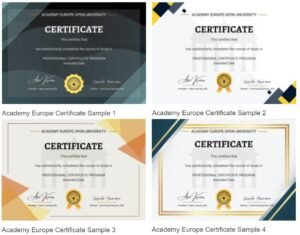Money Management Course is based on text and video learning materials by Academy Europe.
This Academy Europe course excerpt defines customer service and its importance to business success. It distinguishes between internal (e.g., departments within a company) and external customers, highlighting the significance of satisfying both. The text then outlines key characteristics of excellent customer service, including promptness, politeness, professionalism, and attentive listening. Ultimately, the passage stresses that exceeding customer expectations leads to flourishing businesses.
This document summarises the core concepts presented in the Academy Europe “Customer Service Course” excerpt. It focuses on defining who customers are, the importance of customer service, and the key characteristics of providing excellent customer service. The overarching message is that customers are paramount to business success and that consistent, high-quality service is essential for ensuring customer satisfaction and loyalty.
Podcast Link: https://www.youtube.com/watch?v=nnrsLX9sPbk
Key Themes
- The Primacy of the Customer: The text underscores the fundamental role of customers in the success of any business. The core idea is encapsulated in the phrase “Customer is king because he keeps every business afloat.” This highlights that without a customer base, no business can survive or thrive. The document emphasizes that all efforts should be focused on ensuring customer happiness and satisfaction, whether they are potential or existing clients.
- Defining the Customer: The briefing clarifies that a customer is anyone who receives a good, product, service, or idea. Crucially, it distinguishes between two types of customers:
- Internal Customers: These are individuals or groups within an organisation, such as stakeholders, employees, departments, and shareholders. The example given is of a content development team providing material to a packaging department. This definition emphasizes that internal collaboration also requires a focus on service and meeting internal client needs. “Usually, internal customer is part of the organization, like stakeholders, employees, departments or shareholders.”
- External Customers: These are individuals who are outside of the organization who purchase goods or services. The examples given are buying a refrigerator, designer suit, or software, making it clear that anyone who uses a business offering is a customer.
- The Definition and Scope of Customer Service: Customer service is defined as “Taking care of a customer’s needs and solving their problems.” This encompasses all interactions, starting from the initial contact to fulfil a customer’s needs and continuing even after the purchase is complete. The document stresses that this extends through the pre-sale, sale, and post-sale process highlighting the full lifecycle of customer interaction.
- Characteristics of High-Quality Customer Service: The excerpt then outlines the core characteristics that form the foundation of excellent customer service, emphasising that excellent service is about more than just solving problems, it is about the entire customer experience:
- Being Prompt: This involves fulfilling promises made to customers in a timely manner, avoiding delays and cancellations which “can be harmful to you and your organization’s reputation.”
- Knowing your P’s and Q’s: This involves demonstrating politeness throughout all customer interactions, using greetings, and incorporating words like “please,” “sir,” “thank you,” and “sorry” regularly.
- Being Professional: This requires showing empathy for the customers’ problems while always respecting them, and ensuring not to make a customer “feel demeaned because they have a problem they cannot solve by themselves.”
- Striking a Personal Chord: Building a connection by using the customer’s name and engaging with them personally is encouraged to build customer loyalty. The document notes that “A personal touch like calling the customer by name can earn you his loyalty.”
- Listening Attentively: This means actively listening to the customer without interruptions, taking notes of key points, and asking for clarifications later. The importance of this is emphasized so the customer feels heard.
- Asking Right Questions: This involves asking specific questions after thoroughly listening to the customer and utilising a deep knowledge of your product/service to meet the customer’s needs.
- Taking Responsibility: Employees should feel personally responsible for resolving the customer’s queries rather than shifting blame. The emphasis here is on individual ownership of customer satisfaction not being “just a representative of the team and hence onus of the service lies with the whole team.”
Important Ideas and Facts
- Joseph M. Juran’s concept of internal customers (1988): This concept is identified as being essential for organization-wide total quality management. The notion that “an organization that is able to satisfy its internal customers is better equipped to satisfy external customers” is a key takeaway.
- Customer satisfaction is linked to business flourishing: The text repeatedly reinforces the idea that by keeping customers happy and satisfied, the business will prosper.
Conclusion
The core message from this document is that customer service is not simply a department, but a philosophy that must permeate the entire organization. By understanding who the customer is, whether internal or external, and by consistently demonstrating the listed characteristics of quality customer service, businesses can build strong, loyal relationships that contribute to overall success. The emphasis on the customer as “king” makes it clear that their needs and satisfaction are the foundation of a thriving business.
Dear Students,
The text and video based courses by Academy Europe are targeted at providing the students with the most important aspects of the theoretical and methodical materials. In addition, these courses will also focus on the philosophical background for the development and use of the theoretical background and are thus to be understood as partly complementary to the material of the course notes. It is assumed and strongly suggested that the students study and become familiar with the course notes.
Digital Support Resources
All of our Higher Education textbooks are accompanied by a range of digital support resources.
Each title’s resources are carefully tailored to the specific needs of the particular course’s readers.
Examples of the kind of resources provided include:
– A password protected area for instructors with, for example, PowerPoint slides, an instructor’s solutions manual and teaching notes for case studies included in the course.
– An area for students including, for example, useful spreadsheets to accompany case studies in the course, multiple choice questions, discussion questions spreadsheets and useful weblinks.
Empower Academy Europe
Join Academy Europe social media channels on Youtube, Facebook, Linkedin, Twitter and more. Share and like them by using your social media accounts.
Facebook: https://www.facebook.com/academyeurope
Twitter: https://twitter.com/academyeurope
Youtube: https://www.youtube.com/c/academyeurope
Linkedin: https://www.linkedin.com/company/academy-europe/
Certification
Academy Europe presents high-quality formal diplomas, certificates and e-certificates which are formal proof and recognition of accredited online courses. It shows all student’s abilities to learn and achieve high results and is very useful to promote personal career including with CVs, job applications and self improvements.

Curriculum
- 9 Sections
- 9 Lessons
- 10 Weeks
- Customer Service - Introduction1
- Customer Service - Attitude1
- Understanding Customer\'s Problem1
- Customer Service - Generating Business1
- Customer Service - In-Person1
- Customer Service - Over Phone1
- Customer Service - Difficult Customers1
- Electronic Customer Service1
- Customer Service - Mini Case Study1
Requirements
- Ideal candidates for the course would typically possess below:
- Discipline and attentiveness
- Ability to conduct research
- Ability to perform tasks with speed, efficiency, and accuracy
- Analytical judgment
- Patience to interpret technical/scientific data
- A willingness to learn, roll up your sleeves and work toward your dream!
- A computer, tablet or smartphone and an internet connection
- Basic computer skills
Features
- Before you start proceeding with this course on Academy Europe, we are assuming that you have a good aptitude and can think logically. You should want to try something different.
Target audiences
- This course by Academy Europe aims at imparting quality education and training to students.
- Academy Europe is dedicated to its students, their specific learning requirements, and their overall learning success.
- This course is directed toward a student-centered, independent study, asynchronous learning approach.
- After completing this course on Academy Europe, students will get self improvement and promotion in their careers.
- This course is based on at least two learning skills which are provided to the users through audio & visuals, videos, verbal presentations and articles, all of which are asynchronized with distance education approach.


